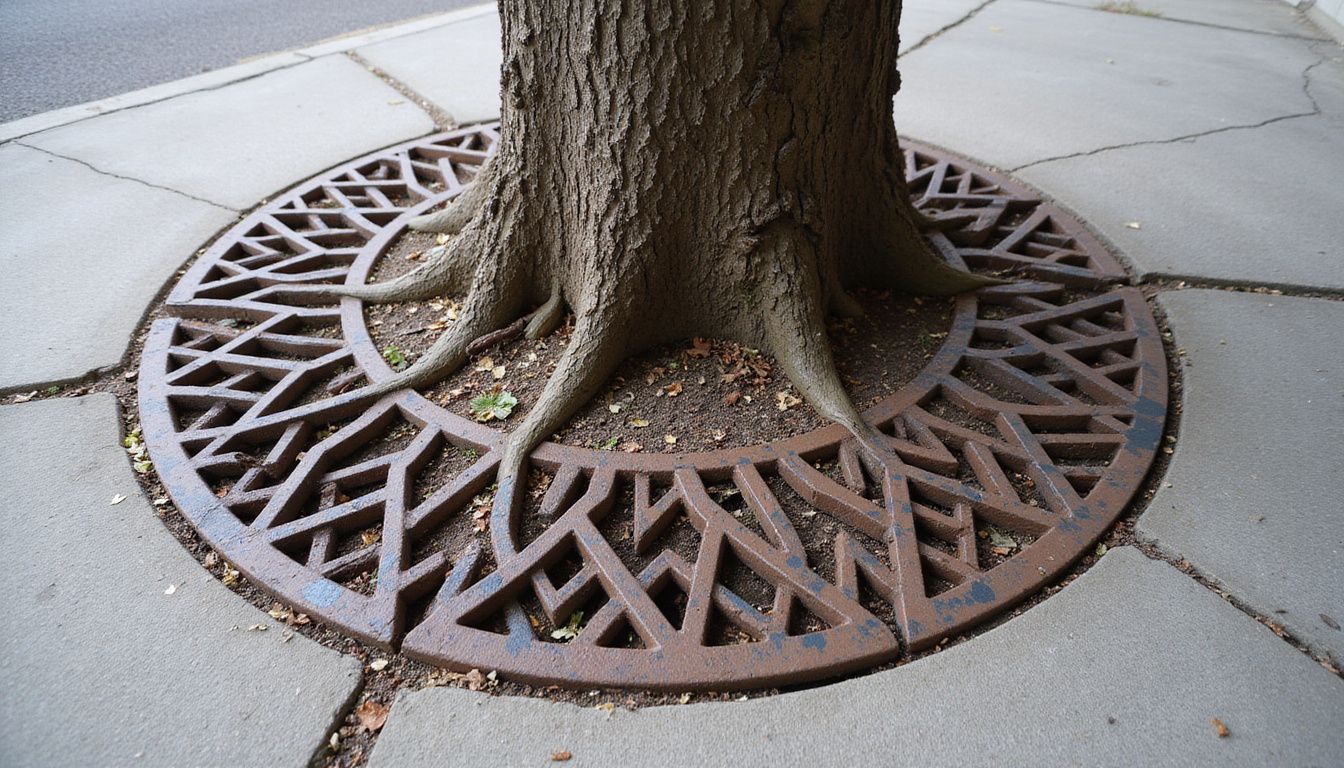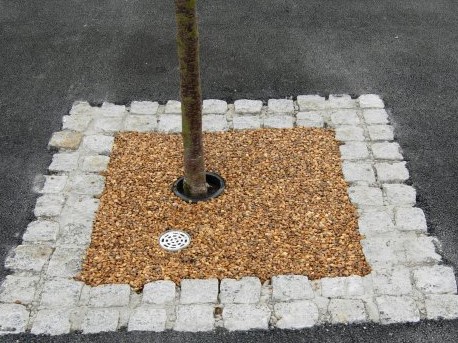
Are you struggling to find ways to protect urban trees without harming them or disrupting city spaces? Many cities, like Manhattan, warn against tree grates because they can damage or even kill trees.
What Are Tree Grates?
Tree grates serve as protective covers placed around the base of urban trees, often in sidewalks or public spaces. They shield the tree’s roots from foot traffic while allowing water and air to reach the soil.
Many individuals view tree grates as a prime solution for balancing the needs of urban tree planting with pedestrian safety. Typically made of materials like cast iron, these structures integrate into city landscapes, supporting sidewalk tree installation.
Concerns arise with their use, as some communities, including Manhattan, discourage tree grates due to their potential to harms. Proper tree pit design remains vital to ensure healthy growing conditions for trees in crowded environments.
Alternatives to Tree Grates
Explore various options that can replace traditional tree grates in urban settings. Discover innovative solutions that support tree growth and enhance city landscapes.
Permeable Tree Pit Surrounds
Permeable tree pit surrounds are engineered to support healthy tree growth in densely populated urban areas. These systems allow rainwater to penetrate the surface and reach the tree roots, which is crucial for long-term health in pavement-heavy environments. They also prevent water runoff and reduce surface flooding, contributing to sustainable urban drainage systems (SUDS). Companies like Optus Resin Technology specialize in permeable solutions that replace bulky cast iron grates with resin-bound surfaces that are ADA-compliant, slip-resistant, and available in a variety of colors and textures to seamlessly blend with surrounding streetscapes. This approach supports both environmental sustainability and pedestrian safety.

Resin-Bound Tree Pits
Resin-bound tree pits use a blend of natural stone aggregates and UV-stable resin to create a porous yet solid surface around urban trees. This design reduces trip hazards commonly associated with metal grates or open soil pits while still allowing for essential air and water exchange. Resin-bound systems are especially favored in high-traffic areas because they offer a clean, uniform look that resists weed growth, compaction, and erosion. Their low maintenance requirements make them an excellent long-term investment for municipalities looking to modernize their streetscapes without compromising tree health.
Sidewalk Cutouts Without Grates
Sidewalk cutouts without grates represent a minimalist, tree-friendly approach to urban landscaping. By leaving the soil exposed within a defined boundary, these cutouts allow maximum airflow and water infiltration, creating ideal growing conditions for urban trees. While they may require more frequent maintenance to keep soil levels stable and prevent tripping hazards, they offer unmatched benefits in promoting unrestricted root growth and natural drainage. These cutouts are often used in cities committed to green infrastructure and low-impact development (LID) strategies. They are also more cost-effective upfront compared to custom-fabricated metal grates.
Mulch and Groundcover Plants
Using mulch or groundcover vegetation as an alternative to tree grates helps mimic natural forest conditions in an urban setting. Mulch helps regulate soil temperature, suppress weeds, and retain moisture, which is vital for young or newly transplanted trees. Groundcover plants, such as low-growing native species or hardy perennials, offer an eco-friendly aesthetic while improving biodiversity and pollinator support in city environments. Together, mulch and plants soften the visual harshness of urban pavement and help prevent soil erosion caused by wind and rain. This solution requires regular maintenance but offers strong ecological and aesthetic benefits.
Paver Blocks and Hardscaping
Paver blocks and hardscape designs are often used to create a structured, clean finish around tree pits in commercial or high-end urban zones. These installations provide a load-bearing surface that protects tree roots from foot traffic and vehicles while still allowing limited water infiltration through joint gaps or permeable designs. Modern paver systems may also include expandable tree rings or removable sections to accommodate root growth over time. This method balances the needs of urban infrastructure with tree protection, especially in areas where design continuity and pedestrian safety are paramount.
Benefits of Using Alternatives to Tree Grates
Explore how switching to options other than tree grates can transform urban landscapes. Discover the distinct advantages these solutions bring to city planning and tree care.
Improved Tree Health
Alternative tree pit solutions play a critical role in supporting long-term urban tree health. Unlike traditional metal grates that can restrict trunk growth and limit water and air penetration, these modern options promote unrestricted root expansion and consistent moisture availability. By facilitating better gas exchange and minimizing soil compaction, they reduce stress on trees and help them establish stronger, deeper root systems. This leads to healthier canopies, longer lifespans, and improved resilience against urban stressors like heat, drought, and pollution. In the long run, healthier trees translate into lower maintenance costs and greater ecosystem benefits for cities.
Enhanced Urban Aesthetics
Modern tree pit alternatives significantly improve the visual appeal of city streetscapes. From sleek resin-bound aggregates that match adjacent walkways to lush groundcover plants that introduce greenery to concrete-heavy zones, these solutions elevate the look and feel of urban environments. Unlike bulky cast iron grates that often corrode or fall out of alignment, newer materials and designs offer clean, customizable finishes that can be tailored to match surrounding architecture or branding initiatives. The result is a more inviting, cohesive public space that enhances property values, attracts foot traffic, and reflects a city’s commitment to smart, thoughtful design.
Sustainable Drainage Solutions
Urban areas are increasingly challenged by stormwater runoff, which can overwhelm sewer systems and contribute to flooding. Tree pit alternatives with permeable designs—such as resin-bound surfaces and open-soil cutouts—help mitigate these issues by allowing rainwater to naturally infiltrate into the ground. This not only replenishes groundwater supplies but also reduces surface runoff and its associated pollutants. Integrated into a broader sustainable drainage system, these tree pit treatments contribute to resilient urban planning strategies that address climate change, prevent erosion, and improve water quality.
Conclusion
Urban landscapes are evolving, and so too are the methods used to support the trees that bring them to life. While traditional tree grates once seemed like a practical solution for protecting street trees, modern research and urban design now point to a range of more effective, tree-friendly alternatives. From resin-bound tree pits and permeable surrounds to mulch, pavers, and plant-based groundcovers, today’s cities have access to smart, sustainable options that prioritize both tree health and urban functionality.
These alternatives do more than just protect roots—they help trees thrive, enhance city aesthetics, and support sustainable drainage, all while ensuring sidewalks remain safe and accessible. As municipalities seek to expand green infrastructure and adapt to climate challenges, rethinking the use of tree grates is a small but powerful step toward building healthier, more resilient urban environments.
Choosing the right tree pit solution is about more than just what’s underfoot—it’s about shaping a city where both people and nature can grow together.


